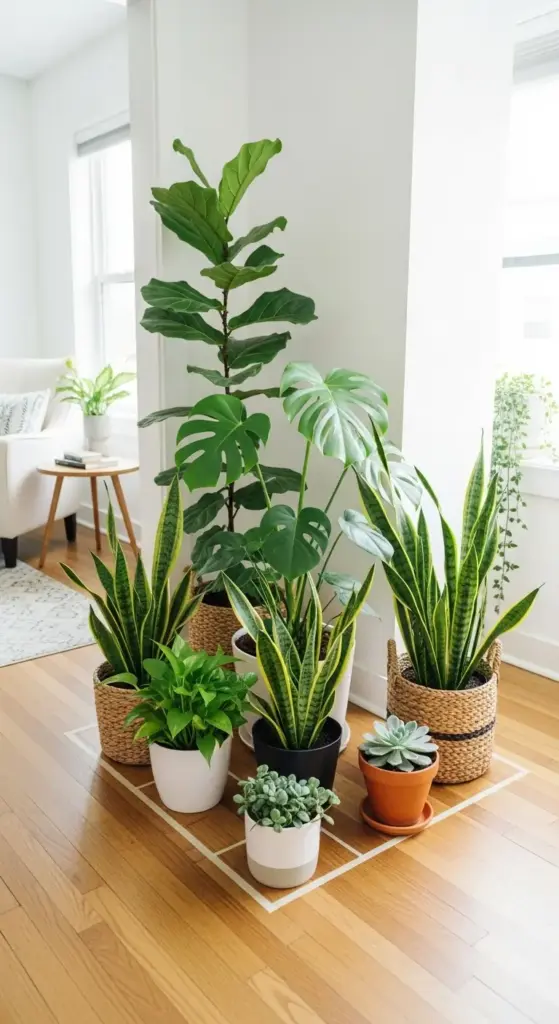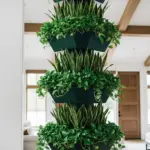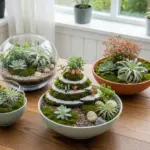4. The Strategic Grouping Formula

I used to just plop plants wherever there was an empty spot. My apartment looked like a plant store after a tornado – everything scattered randomly with no rhyme or reason.
Then I discovered there’s actually math behind beautiful plant arrangements.
Who knew that numbers could make my plants look like they belonged in a magazine?
The Mathematical Approach to Plant Clustering
Here’s what blew my mind: professional plant styling follows specific mathematical ratios. It’s not just “put plants together and hope for the best.”
The golden ratio (1.618 to 1) shows up everywhere in nature and design. For plant groupings, this means your tallest plant should be about 1.6 times taller than your shortest one.
I started measuring everything like a plant scientist, and the results were incredible.
Visual weight distribution follows the 60-30-10 rule too. Your largest plant takes up 60% of the visual space, medium plant gets 30%, and smallest plant fills the remaining 10%.
This prevents any single plant from overwhelming the group or getting completely lost.
I learned this after creating a grouping with three massive plants that looked like they were having a territorial dispute.
Why Odd Numbers Work Magic
This rule seemed weird at first, but odd-numbered groupings (3, 5, 7 plants) always look more natural and appealing than even numbers.
Our brains process odd numbers as more organic and less formal. Even numbers feel too symmetrical and staged.
I tested this theory by rearranging the same four plants into groups of three, and the difference was shocking.
Groups of three are perfect for beginners. One tall plant, one medium, one short – boom, instant professional look.
Groups of five work great for larger spaces. You can create more complex arrangements with varying heights and textures.
Groups of seven or more start getting complicated unless you have serious space to work with.
The triangle principle applies here too – odd numbers naturally form triangular shapes that our eyes find pleasing.
Spacing Secrets for Small Spaces
This is where I made my biggest mistakes early on. I thought cramming plants together would make my tiny apartment look lush and full.
Instead, it just looked cluttered and made the space feel even smaller.
Negative space is just as important as the plants themselves. Your eye needs places to rest between groupings.
For small apartments, I use the “arm’s length rule” – there should be about an arm’s length of clear space between plant groupings.
This creates visual breathing room that actually makes your space feel larger.
Vertical spacing matters too. I learned to stagger plant heights so they don’t all sit at the same level, even when grouped together.
Plant stands, hanging planters, and floor plants at different heights create layers that add depth without taking up more floor space.
The Triangle Method for Foolproof Arrangements
Okay, this technique changed everything for me. The triangle method works for any number of plants and any space size.
Imagine drawing invisible triangles connecting your plants. The triangles can be different sizes, but they should all feel balanced.
For three plants, create one triangle. For five plants, make two overlapping triangles.
Scalene triangles (all different side lengths) look more natural than perfect triangles. Just like in nature, slight irregularity feels more organic.
I place my tallest plant at one triangle point, then position the other plants to complete the shape.
The focal point (usually your most interesting or colorful plant) should sit at the triangle’s most prominent corner.
This method works whether you’re arranging plants on a table, in a corner, or across an entire room.
Distance variation within the triangle keeps things interesting. Some plants can be closer together, others farther apart, as long as the overall triangle shape holds.
I use painter’s tape on the floor sometimes to map out my triangles before committing to plant placement.
Multiple triangle groupings can overlap and interact across larger spaces. Just make sure each triangle feels complete on its own first.
The beauty of this system? It works with any style of plants, pots, or decor. The mathematical relationships create harmony regardless of your personal taste.
Once you start seeing triangles everywhere, you can’t unsee them – and your plant arrangements will never look random again.
Ready to learn how elevation and platforms can make your ceilings look taller and your plants look more expensive? The next section reveals DIY platform ideas using stuff you already own – click below to discover the elevation strategy that transforms any space!









GIPHY App Key not set. Please check settings